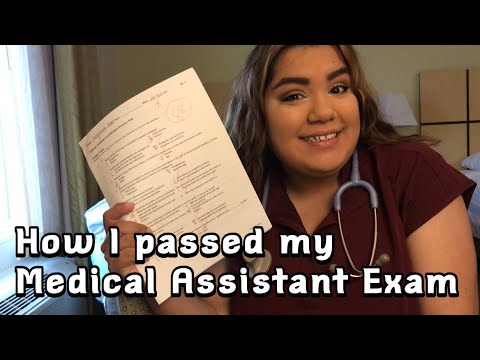Medical Assistant Exam Prep: What You Need to Know
Contents
- Introduction
- What is the Medical Assistant Exam?
- Who is Eligible to take the Exam?
- What is the Exam Format?
- What is the Exam Content?
- How can I Prepare for the Exam?
- What are the Benefits of becoming a Medical Assistant?
- What are the Duties of a Medical Assistant?
- What are the Job Opportunities for Medical Assistants?
- Conclusion
If you’re planning on taking the medical assistant exam, you’ll need to know what to expect. Our blog post will give you all the information you need to know to help you ace the exam.
Checkout this video:
Introduction
Test-takers for the medical assistant certification exams administered by the American Association of Medical assistants (AAMA) and the National Healthcare Association (NHA) can expect to encounter questions related to each of the core functions of medical assisting: administrative, clinical, and general patient care. A wide variety of content areas will be covered, and test questions will be based on tasks typically performed by medical assistants in a variety of care settings.
Although there is some overlap in the content covered by both exams, the AAMA’s Certification Exam for Medical Assistants focuses primarily on administrative tasks, while the NHA’s Certified Medical Assistant Exam emphasizes clinical skills. Questions on both exams may touch on any of the following topics:
-Anatomy and physiology
-Medical terminology
-Common diseases and disorders
-Standard precautions/infection control
-Medical asepsis and sterilization techniques
-Vital signs
-Patient assessment
-EKGs/ECGs
-Medication administration
-Phlebotomy and laboratory procedures
-Injections
-X-rays
What is the Medical Assistant Exam?
The Medical Assistant Exam is a examination that medical assistants may take to credential themselves. Although not required in all states, the certification may give employers and patients peace of mind that their medical assistant has the skills and knowledge necessary to perform the job well. There are several agencies that offer certification, each with slightly different requirements, but most require passing an exam. The exams usually cover topics such as anatomy, physiology, Medical Terminology pharmacology, and medical law and ethics.
Who is Eligible to take the Exam?
There are a few eligibility requirements that must be met in order to take the medical assistant exam. Candidates must have completed a medical assistant program that is accredited by either the Commission on Accreditation of Allied Health Education Programs (CAAHEP) or the Accrediting Bureau of Health Education Schools (ABHES). They must also have graduated from high school or earned a GED.
What is the Exam Format?
The format of the medical assistant exam will vary depending on which credentialing organization you go through. However, most exams will be computer-based and have multiple-choice questions. Some organizations may also include a written component. The test may be open-book or closed-book, and you will likely have a time limit for each section.
What is the Exam Content?
The Medical Assistant Certification Exam is divided into four sections: General Knowledge, Administrative Procedures, Clinical Procedures, and an Externship.
The General Knowledge section covers medical terminology, anatomy and physiology, patient confidentiality, medical office safety, and infection control.
The Administrative Procedures section covers appointment scheduling, medical billing and coding, insurance procedures, and recordkeeping.
The Clinical Procedures section covers taking vital signs, administering medications, performing blood tests and urine tests, preparing patients for exams, and assisting with minor surgery.
The Externship is a practical test of your skills in a real-world medical office setting.
How can I Prepare for the Exam?
There are a few different ways that you can prepare for the medical assistant exam, including:
-Taking a review course: A review course can give you the opportunity to brush up on all of the material that will be covered on the exam.
-Studying on your own: You can find study guides and practice tests online or at your local library to help you prepare for the exam.
-Talking to your instructor: If you have any questions about the material, be sure to talk to your instructor. They may also be able to give you some tips on how to study for the exam.
What are the Benefits of becoming a Medical Assistant?
Medical assistants are in high demand and the demand is expected to continue to grow. Medical assistants perform a variety of duties in physician’s offices, clinics, and other healthcare settings. They are often the first person a patient sees when they come into the office and the last person they see when they leave. Medical assistants play an important role in the healthcare team.
What are the Duties of a Medical Assistant?
Medical assistants are important members of the healthcare team. They are trained to perform both clinical and administrative tasks in a medical office, clinic, or hospital. Clinical duties might include taking and recording patient vital signs, preparing patients for examination, and collecting and processing laboratory specimens. Administrative duties might include scheduling appointments, verifying insurance coverage, and maintaining medical records Many medical assistants have been trained to perform both clinical and administrative tasks, but some may specialize in one area or the other.
What are the Job Opportunities for Medical Assistants?
Medical assistants are in demand! In fact, the Bureau of Labor Statistics projects that employment of medical assistants will grow 29% from 2019 to 2029, much faster than the average for all occupations.
With such high demand, you may be wondering what the job opportunities are for medical assistants. Here’s a quick overview:
Clinical medical assistants work in doctors’ offices and other outpatient care centers. They take medical histories, prepare patients for examinations, collect blood and other laboratory specimens, and perform basic laboratory tests. They also may give injections and help remove sutures. In some states, they may be allowed to give medications prescribed by the supervising physician or nurse.
Administrative medical assistants perform both clinical and administrative tasks. They take and record patients’ vital signs and histories, prepare patients for examination, schedule appointments, bill patients, manage Medical records place insurance claims, transcribe physicians’ progress notes on charts, answer telephones, prepare correspondence, schedule hospital admissions and laboratory services, maintain inventory of office supplies and equipment.
Both types of medical assistants typically complete a postsecondary education program of at least one year. Some states require certification or licensure for certain tasks performed by medical assistants.
Conclusion
You’ve made it to the end of our Medical Assistant Exam Prep course! By now, you should feel confident and well-prepared to take your certification exam. Remember to review all of the material covered in this course, including:
-Anatomy and physiology
-Medical terminology
-Common diagnostic tests and procedures
–patient privacy and ethical considerations
-How to perform a physical examination
-Charting and documentation
– pharmacology
We wish you the best of luck on your exam!







